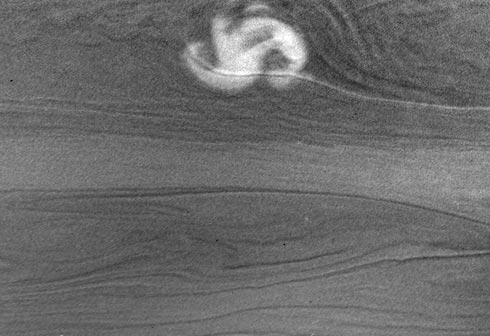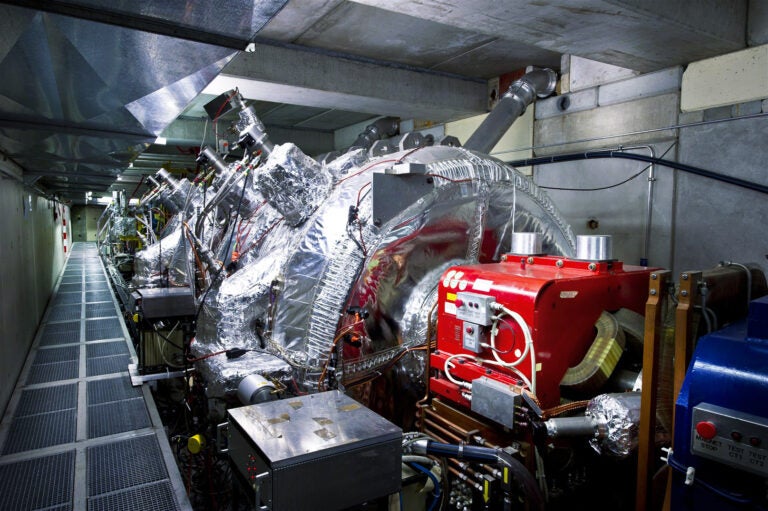A dynamic storm on Saturn is blasting radio noise at the Cassini spacecraft orbiting the planet. The noise, scientists say, comes from lightning bolts 1,000 times stronger than anything seen on Earth.
“It is clear that this is the strongest lightning activity that we’ve seen yet with Cassini since it has arrived at Saturn,” says the University of Iowa’s Don Gurnett, principal investigator for Cassini’s Radio and Plasma Wave Science (RPWS) instrument, which detected the signals. “In fact, the flash rate even exceeds the rate observed by Voyager 1 back in 1980, and the intensities are at least as large, if not larger.”
On January 23, the Cassini spacecraft began detecting cracks, pops, and hisses similar to those heard on an AM radio during a terrestrial thunderstorm. “Most people think it’s interference,” says Bill Kurth, deputy principal investigator on Cassini’s RPWS. “Those cracks and pops are radio emissions that are generated by the lightning flashes.”
While Earth-based telescopes could spot the storm as it rotated across the planet’s sunlit side, the Cassini spacecraft was unable to do so. It was positioned behind the planet and able to image only the night side.
Michael Kaiser, an RPWS team member at NASA’s Goddard Space Flight Center in Greenbelt, Maryland, contacted Julius Benton, Jr., director of the Association of Lunar and Planetary Observers, and asked him to query members for any new bright clouds in Saturn’s atmosphere.
“I heard back very quickly from Erick Bondoux and Jean-Luc Dauvergne of Melun, France, two amateurs who worked together,” says Kaiser. “Amateurs are playing an increasingly important role supporting professional astronomy research. The equipment available now is incredible, much better than when I was an amateur.”
Sunlight at Saturn is 100 times dimmer than at Earth due to the ringed planet’s 10-times-greater distance from the Sun. Nevertheless, says Ingersoll, the light the rings cast onto Saturn’s cloud tops is 10 times brighter than that of a Full Moon on Earth. But while “ringshine” obscured lightning flashes, it was bright enough to let Cassini’s cameras make out atmospheric features and image the storm.
“Since we’ve been in orbit, we’ve detected maybe four or five such storms,” explains Kurth. “This is by far the strongest that we’ve detected with Cassini. And it’s even stronger and there’s more activity than the storms that were detected by the two Voyager spacecraft back in the early 1980s.”
The new storm lies in a region of Saturn’s southern hemisphere scientists refer to as “storm alley” because of the numerous systems it has produced since Cassini’s 2004 arrival. The storm spans about 2,175 miles (3,500 kilometers) — larger than Earth’s Moon — in its north-south dimension.
“It’s really the only large storm on the whole planet,” Ingersoll notes. “It’s in the right place and it appeared at the right time to match the radio emissions, so it has to be the right storm.”
As revealed by Cassini’s cameras, the storm bears a slight resemblance to a hurricane, with four spiral arms arcing toward its center. “Every day, those arms are changing,” Ingersoll says. “It’s very dynamic.”
“With Cassini, we have learned that lightning storms can emerge suddenly and last for several weeks or even a month,” says Georg Fischer, a postdoctoral researcher at the University of Iowa. “On the other hand, we have only observed a single smaller lightning storm throughout 2005, which is remarkably different compared to what we know about terrestrial thunderstorms.”
“Saturn seems to do this,” says Ingersoll. “It’s quiet for a long time, and then ‘burps’ with a single giant storm.”











